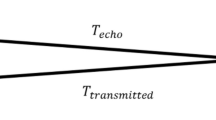Abstract
We first show that for some kinds of signals a “bandwidth and time duration reduction technique” can be used to simulate waveform distortions caused by moving targets, that is, it is correct to measure the waveform distortions at very large TB with relatively small υ by reducing TB and increasing υ while keeping TBυ unchanged, where T is the duration of the transmitted signal, B is the bandwidth and υ is the relative speed of targets. We then study the waveform distortions in SAR signals caused by moving antenna. Based on the bandwidth and time duration reduction technique, a lot of time and memory are saved in simulations. We then confirm by simulations that waveform distortions do pose problems when processing very large bandwidth and long duration SAR data using conventional SAR processing methods. Finally we propose the concepts of wideband and narrowband processing of SAR data. Models are set up for wideband and narrowband SAR data processing, and new methods are presented for reconstructing targets using the proposed models. Simulations show that the methods can improve the quality of the simulated SAR images.
Similar content being viewed by others
References
M. Burgos-Garcia, J. Sanmartin-Jara, F. Perez-Martiniz, and J.A. Retamosa, “Radar Sensor Using Low Probability of Interception SS-FH Signals,” IEEE AES Systems Magazine, vol. 15, April 2000, pp. 23–28.
W. Carrara, R.S. Goodman, and R.M. Majewski, Spotlight Synthetic Aperture Radar: Signal Processing Algorithms, Artech House, 1995.
C. Elachi, “Space Imaging Radar in Planetary Exploration and Earth Observation,” AIAA Journal, vol. 39, no. 4, 2001, pp. 553–563.
B. Huneycutt and J. Zuzek, “Frequency Use and Needs of Spaceborne Active Sensors,” International Geoscience and Remote Sensing Symposium (IGARSS), vol. 6, 2000, pp. 2457–2463.
M.G.M. Hussain, “Ultra-Wideband Impluse Radar-an Overview of the Principles,” IEEE AES Systems Magazine, Sept. 1998, pp. 9–14.
Q. Jin and K.M. Wong, “The Estimation of Time Delay and Doppler Stretch of Wideband Signals,” IEEE Transactions on Signal Processing, vol. 43, no. 4, April 1995, pp. 904–916.
D. Klugmann, “A Compact 94-GHz FM-CW Doppler Cloud Radar Using Semiconductor Devices for Power Generation,” Proceedings of IEEE International Conference on Geoscience and Remote Sensing Symposium (IGARSS), vol. 5, 2000, pp. 1801–1803.
X.X. Niu, P.C. Ching, and Y.T. Chan, “Wavelet Based Approach for Joint Time Delay and Doppler Stretch Measurements,” IEEE Transactions on Aerospace and Electronic Systems, vol. 35, no. 3, July 1999, pp. 1111–1119.
S. Noda, K. Inomata, M. Watanabe, T. Fukae, and M. Tobioka, “A Millimeter-Wave Radar for Train Application,” Proceedings of IEEE International Conference on Vehicle Electronics Conference (IVEC), vol. 1, 1999, pp. 153–158.
J.F. Pietrasinski, T.W. Brenner, and C.J. Lesnik, “Selected Tendencies of Modern Radar and Radar Systems Development,” Proceedings of 12th International Conference on Microwave and Radar, vol. 1, 1998, pp. 133–137.
A.W. Rihaczek, Principles of High Resolution Radar, McGraw-Hill, 1969.
M.I. Skolnik, Introduction to Radar System, 3rd ed., McGraw-Hill Higher Education, 2001.
M. Soumekh, Synthetic Aperture Radar Signal Processing with MATLAB Algorithms, John Wiley & Sons, INC. 1999.
J.D. Taylor, Ultra-Wideband Radar Technology, CRC Press, 2000.
B. Walker, G. Sander, M. Thompson, B. Burns, R. Fellerhoff, and D. Dubbert, A High-Resolution, Four-Band SAR Testbed with Real-Time Image Formation, http: //www.sandia.gov/radar/files/igarss96.pdf.
L.M.H. Ulander, P.O. Frolind, and T. Martin, Processing and Calibration of Ultra-Wideband SAR Data from CARABAS-II, http: //www.estec.esa.nl/ceos99/papers/p143.pdf.
L.G. Weiss, “Wavelets and Wideband Correlation Processing,” IEEE Signal Processing Magazine, no. 1, Jan. 1994, pp. 13–32.
X.B. Yang, J.Y. Yang, and C.G. Jing, “A Research on Millimeter-Wave LFMCW Radar for Air-Field Object Imaging,” Conference Digest of International Conference on Infrared and Millimeter Waves, 2000, pp. 413–414.
M.C. Zari, A.F. Zwilling, D.A. Hess, J. Jo, C.S. Anderson, and D. Chiang, “Soldier Identification System Utilizing Low Probability of Intercept (LPI) Techniques,” IEEE AES Systems Magazine, vol. 12, July 1997, pp. 21–26.
Rights and permissions
About this article
Cite this article
Lin, Z., Zeng, Y., Bi, G. et al. Signal Processing for Large Bandwidth and Long Duration Waveform SAR. Multidimensional Systems and Signal Processing 14, 119–137 (2003). https://doi.org/10.1023/A:1022225225903
Issue Date:
DOI: https://doi.org/10.1023/A:1022225225903




